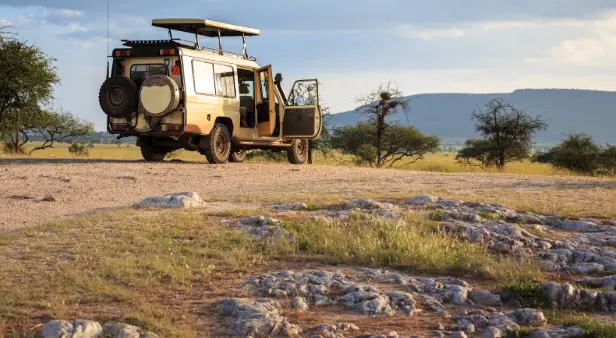Picture two million hooves thundering across endless plains, desperate mothers protecting newborn calves, and crocodiles lurking beneath muddy waters. This isn’t a scene from a nature documentary – it’s the Great Migration in Tanzania, and you can witness it firsthand.
Every year, travelers struggle with timing, location choices, and planning complexities that can make or break this once-in-a-lifetime experience. You’ll discover exactly when and where to position yourself for maximum impact, plus insider strategies that ensure you’re not just another disappointed tourist staring at empty grasslands.
Understanding Tanzania’s Great Migration Phenomenon
This natural spectacle is more than animals crossing borders; it’s Earth’s most dramatic survival story. The sheer scale and intensity of Tanzania’s Great Migration make it unlike any other natural event on the planet.
What Makes Tanzania’s Wildlife Migration Extraordinary
The migration unfolds as a breathtaking rhythm of nature. Vast herds sweep across the Serengeti in search of fresh grazing and water. Beyond survival, the journey reveals dramatic predator-prey encounters, creating unforgettable moments in the wild.
Planning a Tanzania Safari Experience
Witnessing the migration during a Tanzania safari offers travelers a front-row seat to this living masterpiece. Each stage of the journey presents unique landscapes and wildlife interactions.
Scientific Insights Behind Migration Patterns
GPS tracking shows flexible routes influenced by rainfall and mineral-rich grasses. Wildebeest detects nutrient levels from afar, proving timing predictions require more than calendar dates.
Conservation Success Story of Modern Migration
Anti-poaching efforts and community conservancies now safeguard the herds. Tourism revenue funds rangers and monitoring programs, ensuring this timeless migration endures for future generations.
Strategic Planning for Your Great Migration Tanzania Safari
Success depends on aligning your goals with timing, location, and operator choice. Smart planning can mean the difference between legendary river crossings and empty landscapes.
Choosing Your Migration Experience Focus
Calving season offers intimate scenes as newborns take their first steps under predator watch. River crossings deliver heart-stopping drama as herds face crocodile-filled waters.
Tailored Tanzania Safari Experiences
For travelers exploring a Tanzania safari, operators like Sababu Safaris design customized trips from family-friendly adventures to professional photography tours, ensuring your experience matches personal interests.
Budget Planning and Cost Optimization Strategies
Peak season rates run far higher than shoulder months. Mobile camps bring proximity but at premium costs, while lodges offer stable rates with longer drives. Group joining trips cut expenses significantly but reduce flexibility.
Selecting Your Tanzania Safari Operator
Verify operator credentials and safety certifications. Local providers deliver cultural depth, while international operators ensure consistency. GPS tracking and real-time communication distinguish exceptional guides who anticipate sudden herd movements.
Timing Your Serengeti Safaris for Maximum Impact
Migration timing has become less predictable due to shifting climate patterns, making flexibility essential. Understanding traditional routes alongside modern tracking methods ensures you don’t miss unforgettable moments.
Real-Time Migration Tracking and Prediction Methods
Satellite imagery provides weekly updates through apps and websites, while GPS collars deliver near-real-time accuracy. Weather forecasts help predict movements up to two weeks ahead.
Mobile Tracking Advantages
Safari operators now share instant sightings via WhatsApp and radio networks. Camps adjust routes or relocate within hours, ensuring travelers stay close to herd activity.
Peak Season Strategic Planning (July–October)
Book lodges 12–18 months ahead for prime river crossings. Northern Serengeti safaris provide the best chances, though crowds peak. Early mornings, especially between 7–10 AM, offer higher crossing probabilities.
Shoulder Season Advantages (April–June, November–December)
Fewer tourists create intimate encounters, striking photography opportunities, and cost savings of 30–50%. April-May highlights mating behaviors, while November-December showcases the herds’ return south.
Regional Hotspots for Witnessing Great Migration
Each Serengeti region offers unique highlights depending on season and traveler interests. Understanding these geographical differences helps maximize wildlife encounters throughout the migration cycle.
Southern Serengeti Calving Grounds Mastery
From December to March, the Ndutu Plains transform into a vast nursery. Short-grass landscapes allow clear views of newborn calves and mothers. Predator concentrations peak, as lions, cheetahs, and hyenas hunt vulnerable young.
Western Corridor River Crossing Excellence
Between May and July, the Grumeti River hosts early crossings. Smaller points create intimate viewing with fewer vehicles. Established crocodile populations heighten drama, while guides track active sites along a 40-kilometer stretch.
Local Knowledge Advantage
Experienced guides monitor water levels and predator patterns, ensuring travelers reach the most dynamic crossing locations.
Northern Serengeti Mara River Drama
From July to October, the Mara River delivers iconic crossings. Lamai Wedge offers exclusivity compared to crowded Kogatende. Extended stays increase the chances of witnessing unpredictable but unforgettable action.
Accommodation Strategies for Migration Following
Your choice of base camp directly shapes your migration experience. The right accommodation places you close to the action, while poor positioning risks missed opportunities.
Mobile Camp Adventures vs Permanent Lodge Stability
Mobile camps move with the herds, ensuring proximity to wildlife at every phase. For example, Esirai Mobile Migration Camp relocates seasonally, keeping guests within 30 minutes of major activity. Permanent lodges, by contrast, provide consistent amenities but often require long drives to reach herds.
Private Conservancy Exclusive Experiences
Grumeti Reserves and Singita concessions offer access beyond national park limits, including night drives and walking safaris. Community-run conservancies add authentic cultural connections, with revenue supporting local Maasai communities.
Budget-Conscious Options Without Compromise
Public campsites like Seronera and Naabi Hill cost under $30, placing visitors near permanent water sources. Budget lodges near park gates balance affordability with comfort, offering savings that extend travel duration or enable multi-park itineraries.
Advanced Photography and Cultural Integration
Documenting Tanzania’s Great Migration goes beyond casual snapshots. Combining professional techniques with cultural respect creates images and experiences that capture the true spirit of this natural wonder.
Professional Photography Equipment Essentials
Long telephoto lenses (400–600mm) allow intimate behavioral shots without disturbing wildlife. Weather-sealed cameras withstand dust storms that sweep across the plains, while multiple camera bodies make it easy to switch between wide landscapes and action scenes.
Field Equipment Tips
Dust protection is critical, carrying cleaning kits and filters to keep gear clear. Battery life fades quickly in remote camps, so portable chargers and spare batteries ensure uninterrupted shooting.
Capturing Iconic Migration Moments
River crossings demand patience and positioning. Observing lead animals testing the water helps anticipate timing. Burst shooting modes capture the intensity of herds plunging into crocodile-filled rivers.
Seasonal Photography Opportunities
The calving season shifts focus to tender mother-newborn interactions. Early morning light produces backlit images that highlight peaceful grazing before the heat sets in.
Maasai Community Authentic Encounters
Local Maasai guides share traditional migration knowledge rooted in seasonal cues. Respectful visits to villages or schools provide a genuine cultural exchange. Supporting community programs ensures benefits reach families directly, enriching your journey with deeper meaning alongside breathtaking photographs.
Your Path to Migration Magic
Witnessing the Great Migration transforms from a dream to reality through careful planning and realistic expectations. Success comes from understanding that this natural phenomenon operates on nature’s schedule, not tourist calendars. The most rewarding experiences happen when you embrace flexibility over rigid itineraries, allowing spontaneous moments to unfold naturally.
Whether you’re watching newborn calves take first steps or holding your breath during heart-stopping river crossings, Tanzania’s Great Migration offers life-changing encounters that remind us why some experiences simply can’t be replicated anywhere else on Earth.
Common Questions About Great Migration Safaris
1. Where is the best safari to see the Great Migration?
Tanzania offers the best overall experience, especially from early to mid-September. Northern Serengeti’s Mara River area provides dramatic crossings, while central Serengeti offers excellent year-round wildlife viewing opportunities.
2. Is the Masai Mara or the Serengeti better for the Great Migration?
Depends on timing – Masai Mara excels July-October for migration viewing, while Serengeti peaks June-August for crossings and January-March for calving season. Both offer spectacular year-round game viewing beyond migration events.
3. What is the best time to see Great Migration during the shoulder seasons?
Absolutely! April-June and November-December offer fewer crowds, dramatic skies, and 30-50% cost savings while maintaining excellent wildlife viewing opportunities throughout migration transition periods.
Also Read-How to Extend the Life of Your Aluminium Toolbox








